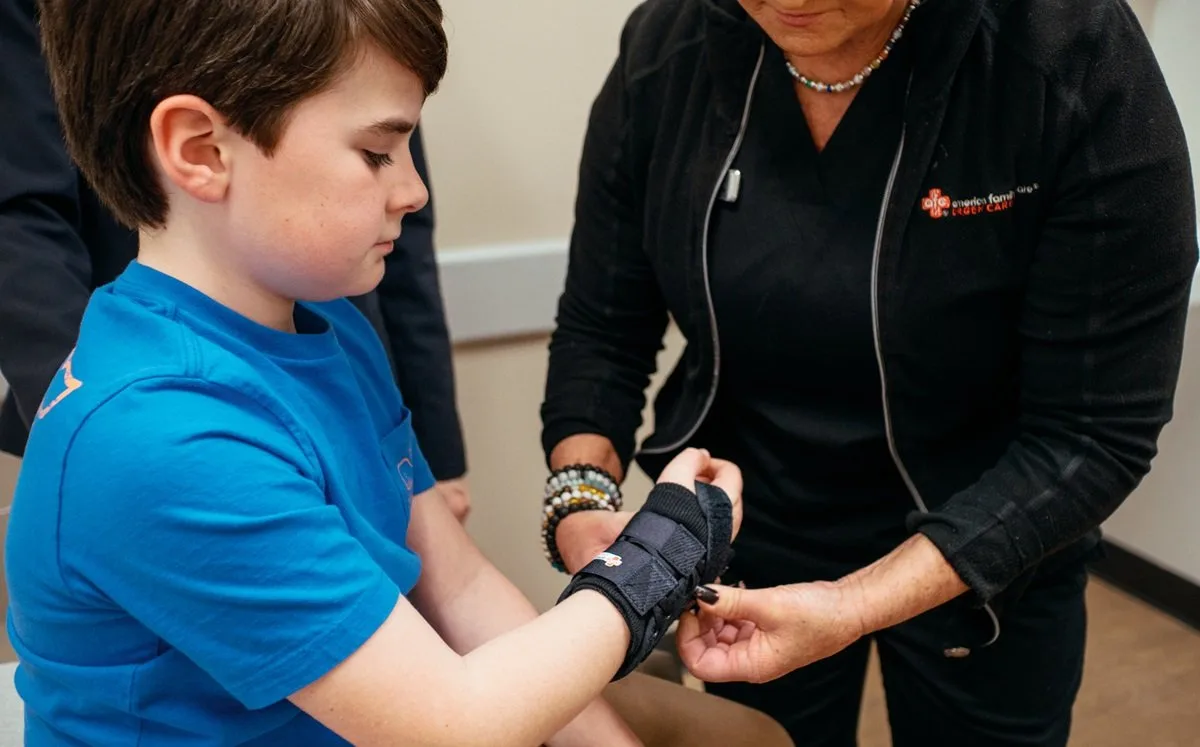Hand & Wrist Pain | Work & Sports Related Injuries
Life happens, and so do accidents. But don’t worry, AFC Urgent Care is here to help. We are open 7 days a week with extended hours, so we can get you the care you need to get back to your life as soon as possible.

Pre-Register for an Appointment
Whether you’re an athlete dodging tackles or a construction worker wielding a hammer, you’re at risk of hand and wrist injuries. These delicate joints are prone to sprains, strains, and fractures from a variety of causes, including falls, repetitive motions, and sudden impacts.
What Are The Most Common Hand & Wrist Injuries You Treat?
Work-related injuries can include repetitive strain injury, carpal tunnel syndrome, tendonitis, burns, lacerations, and broken bones. Sports-related injuries can include traumatic injuries such as joint dislocations, sprains, broken bones, tendon inflammation, and ligament tears, as well as overuse injuries.
Most hand and wrist injuries can be fully recovered from with proper management. However, it’s important to see a doctor right away if you experience any pain, swelling, or difficulty moving your hands or wrists.
What Should I Do If I Injure My Hand or Wrist?
For minor hand injuries, you can often manage them at home with a well-rounded game plan. Try following the RICE method. Give your hand some much-needed Rest, cool things off with an Ice pack, provide gentle wrapping for Compression, Elevate the limb to reduce swelling, and consider using over-the-counter anti-inflammatory medication like ibuprofen or naproxen to help with the pain and swelling. Remember, these simple steps can make a big difference in your recovery.
When to Go to Urgent Care for a Hand or Wrist Injury
Severe Pain
Pain is a subjective experience, so it can be difficult to define what constitutes “severe” pain. However, if the pain is so intense that it interferes with your ability to function in your daily life, it is likely severe enough to seek medical attention. Some signs of severe pain include:
- Pain that is so intense that it makes it difficult to think or concentrate
- Pain that is so severe that it prevents you from sleeping
- Pain that is so severe that it makes it difficult to move your hand or wrist
- Pain that is accompanied by other symptoms, such as swelling, numbness, or coldness
Severe Swelling
Swelling is a natural response to injury. However, severe swelling can be a sign of a more serious injury, such as a broken bone, ligament tear, or tendon rupture. Some signs of severe swelling include:
- Swelling that is so severe that it makes it difficult to move your fingers or wear rings
- Swelling that is accompanied by pain, redness, or warmth
- Swelling that does not improve after a few days
Numbness
Numbness is a loss of sensation in a particular area of the body. It can be caused by damage to the nerves that supply that area. Numbness in the hand or wrist can be a sign of nerve damage caused by a variety of factors, including:
- Injury, such as a broken bone, ligament tear, or tendon rupture
- Repetitive strain injury
- Arthritis
- Diabetes
- Certain medications
Coldness or Grayness
Coldness or grayness in the hand or wrist can be a sign of a circulation problem. This can happen due to issues like nerve damage, blood flow problems, or tissue damage in the hands or fingers.
Twisting or Bending
If your hand or finger looks deformed or bent at an odd angle, this could be a sign of a broken bone or dislocated joint. Broken bones can occur from a variety of injuries, including falls, blows to the hand or wrist, and sports injuries. Dislocated joints occur when the bones of a joint are forced out of their normal position.
Noisy Movements
If you hear strange clicking, grating, or popping sounds when you move your hand or wrist, this could be a sign of a torn ligament or tendon. Ligaments are tough bands of tissue that connect bones to each other. Tendons are tough bands of tissue that connect muscles to bones. Tears in ligaments or tendons can occur from a variety of injuries, including repetitive strain injuries and sports injuries.
Persistent Bleeding
Bleeding is a normal part of some injuries, such as cuts and scrapes. However, persistent bleeding can be a sign of a more serious injury, such as a deep cut, blood vessel injury, or bleeding disorder.
AFC Urgent Care is here to help you when you experience a hand or wrist injury. Our experienced medical team will provide a thorough evaluation and, if necessary, conduct X-rays to ensure a proper diagnosis. Whether your injury is minor enough to manage at home or requires medical attention, we’ll provide comprehensive care to get you back on track quickly and safely. Your well-being is our top priority, so don’t hesitate to reach out if you need us.
If you can’t make it to AFC immediately after an incident, use the R.I.C.E. method. |
Rest – After an accident, get to a comfortable location as soon as possible, and rest to prevent additional strain on the injury.
Ice – Wrap an ice pack in a towel and apply it to the injury for 15 to 20 minutes. Reapply the ice every 3 hours. If you don’t have an ice pack, a bag of frozen produce will get the job done.
Compress – Put pressure on the injured area by wrapping it with an elastic bandage. Make sure the bandage is tight but not too tight. You can tell if the bandage is too tight when the injured area turns blue or starts feeling numb.
Elevate – To properly elevate your injury, position the injured area to rest above your heart. The most common way to elevate the injury is to stack several pillows under your foot, arm, ankle or leg while resting in bed or on a sofa.

Don't wait to get the medical attention you need.
CALL US TODAY | (423) 458-1426


